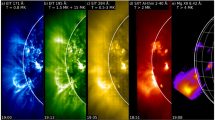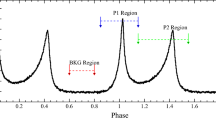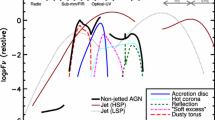Abstract
THE satellite Ariel V, launched on October 15, 1974, as part of the US-UK collaborative space programme, contains a rotation modulation collimator experiment designed to measure the positions of X-ray sources, which was built by the Mullard Space Science Laboratory. The experiment responds to X rays in the quantum energy range 3.1–9.3 keV, the area of the proportional counters being 256 cm2 which, allowing for grid transmission, counter efficiency and so on, leads to an effective area of 102 cm2 at 6.0 keV. The pitch-to-separation ratio of the collimator grids is 112, corresponding to a full width at half maximum (FWHM) of the image of a point source of 15′ (ref. 1). The spin axis was manoeuvred to point towards a number of sources in succession in the Centaurus region, including the important binary source Cen X-3, from December 17, 1974 to January 31, 1975, to carry out position and spectrum determinations. Soon after arriving at the first pointing direction in the sequence, a correlation map produced by overlaying data from orbits obtained on December 17–19 showed the presence of a new source not listed in the Uhuru (3U) catalogue, which we have designated A1118-61 from the position given below. The field of view of the experiment is 17° FWHM, so that the light curve could be followed over an interval of 46 d. The light curve is given in Fig. 1 in units of counting rate in our detector, which can be converted approximately to Uhuru counts by multiplication by 8. In the initial and final periods of observation, the source was rather weak, and could be detected at a satisfactory significance only by overlaying orbits, with a consequent reduction in time resolution. The latter improved to one orbit (101 min) when the source was near its maximum brightness. We have, for clarity, averaged the intensity over 12 h in this period, but significant intensity variations, exceeding those attributable to counting statistics, were observed in the one-orbit averages. Where an upper limit only is given, it corresponds to three standard deviations of the background level.
Similar content being viewed by others
References
Willmore, A. P., Mon. Not. R. astr. Soc., 147, 387 (1970).
Evans, W. D., Belian, R. D., and Connor, J. P., Acrophys. J. Lett., 159, L57 (1970).
Ives, J. C., Sanford, P. W., and Belz Burnell, S. J., Nature, 254, 578 (1975).
Parkinson, J. H., Mason, K. O., and Sanford, P. W., Nature, 249, 746–747 (1974).
Author information
Authors and Affiliations
Rights and permissions
About this article
Cite this article
EYLES, C., SKINNER, G., WILLMORE, A. et al. Variable X-ray source near Cen X-3. Nature 254, 577–578 (1975). https://doi.org/10.1038/254577a0
Received:
Published:
Issue Date:
DOI: https://doi.org/10.1038/254577a0
- Springer Nature Limited
This article is cited by
-
Wide field monitoring of the X-ray sky using Rotation Modulation Collimators
Experimental Astronomy (1995)
-
The first uv studies of the optical candidate for the X-ray source 1118-61
Astrophysics and Space Science (1985)
-
Second catalogue of X-ray sources
Astrophysics and Space Science (1982)
-
The eccentric-orbit binary model for the transient X-ray sources
Astrophysics and Space Science (1977)
-
Spectral characteristics of transient X-ray sources
Nature (1976)





